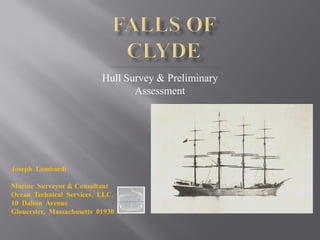Falls Of Clyde, Project Management, 2008
- 1. Hull Survey & Preliminary Assessment Joseph Lombardi Marine Surveyor & Consultant Ocean Technical Services, LLC. 10 Dalton Avenue Gloucester, Massachusetts 01930
- 2. FALLS OF CLYDE Scottish built, wrought iron hull, fully rigged ship/barque, part of the Matson Line that traded from from San Francisco & other West Coast ports to Honolulu. Ship rescued from breakers and towed to Honolulu in the 1960s, restored and then allowed to languish with minimal care until in an unsafe condition with falling rigging, rot in her topmasts/jib boom and deteriorated stand- ing rig. Hull in poor material condition and in imminent danger of sinking at Honolulu Maritime Museum berth downtown. Ship advertised around world, no takers. Bishop Museum decides for at-sea disposal of vessel at 15 mile disposal site in deep water.
- 4. The ship was down-rigged by Brian TossŌĆÖs crew in July and August of 2008 with all rig- ging safely removed and the remaining spars properly strengthened. The stem and stern of the ship were strength- ened with the addition of steel plate, steel rods, underwater patching, removal of rudder and the removal of the bow sprit and figurehead. A disposal site was chosen and approved by the EPA & USCG and the vessel was rigged for tow after approval was obtained for the Tow Plan and Ship Disposal Plan.
- 5. Decision Process: 1.) No funding source for restoration, 2.) Vessel in danger of losing part/all of standing rig, 3.) Danger to adjacent commercial berth and Museum structure due to possible loss of stability and capsizing, 4.) Extremely poor hull condition with wasted bulkheads, framing & decks. 5.) Loss of hull insurance, 6.) No ŌĆśWhite KnightŌĆÖ to take vessel away, 7.) Scrapping not an alternative in Hawaii. Decision made for at-sea disposal of vessel.
- 8. THE FOLLOWING PHTOGRAPHS DEPICT HISTORICAL PHOTOS OF FALLS OF CLYDE DURING HER SAILING DAYS AND BEFORE DOWN-RIGGING AND PREPARATION OF ’é© VESSEL FOR DEEP SEA DISPOSAL.
- 10. ’é©
- 24. ’é© The rig was in poor (and dangerous) condition. ’é© The bowsprit was failing and in danger of falling at any time. ’é© Wooden topmasts were rotted and were be removed with associated damaged/rotted yards and standing/running rigging. ’é© Forecastle & Maindeck has serious wooden deck issues and needs replacement throughout. ’é© Interior support scantlings/frames for all spaces are in poor/fair condition and require extensive repair/replacement. ’é© All interior hull transverse and longitudinal bulkheads holed, or are non-existent and are non-watertight and require repair/replacement. ’é© Extensive shell plating is holed and/or suffering > 80% plate loss. ’é© Many temporary wooden plugs and/or DC plugs were keeping out water. ’é© Extensive separation of shell plating from structural framing due to corrosion of rivet and plate lap seams. ’é© New coating system failed in Tanks # 4 & 5 with resultant rust/scale. Rust/scale and oil waste from tanks was sandblasted and being dumped into lazarette & Tanks # 4 & 5. ’é© No flooding alarm system installed. No standby pumping capability aboard. ’é© Rudder assembly totally rotted away at waterline and unsupported.
- 36. ’é© Side shell framing separated from shell plating as rivets have failed.
- 37. ’é© Wooden plugs keeping sea water from sinking FOC, aft.
- 38. ’é© Transverse bulkhead of swiss cheese. Totally ineffectual structural member.
- 43. ’é© The bowsprit is rotten and in danger of falling away.
- 44. The top rig (of wood and associated rigging) wass in poor/dangerous condition and needs to be taken down immediately.
- 45. ’é© Wooden blocks (as depicted above) were in danger of carrying away and endangering personnel below.






















































